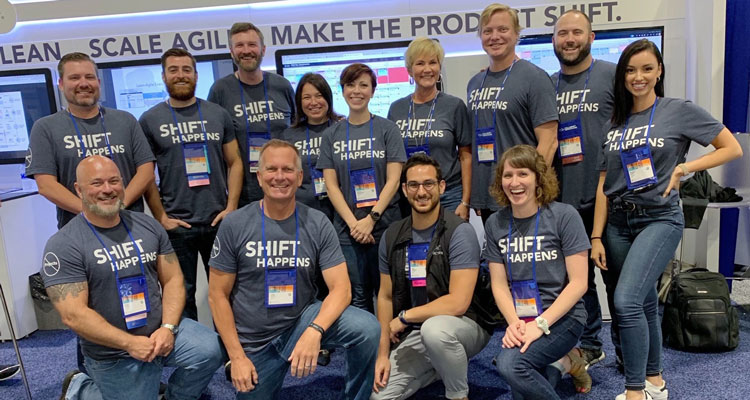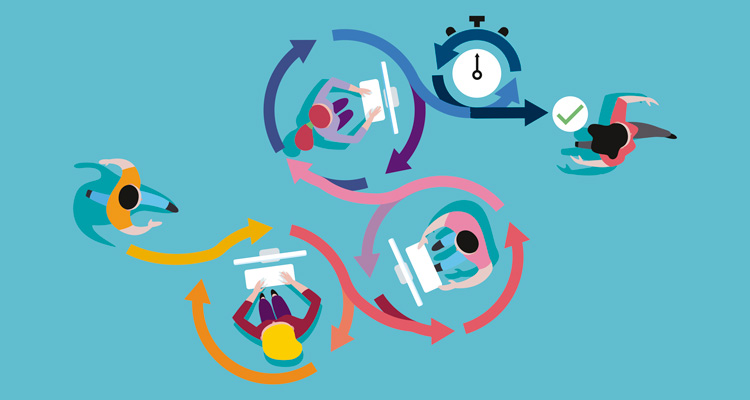
The Agile 2019 conference confirmed that the community energy around Agile, as a better way of working, has not wavered. The positive vibe was palpable throughout the conference, as I overheard and took part in conversations around scaling Agile adoption. Those in attendance were excited, engaged, and enthusiastic to learn about improving and growing the Agile mindset in their companies.
Because at the end of the day, shift happens. What matters is how, and how fast, you handle and adjust to that shift. The more sense-and-respond iteration loops your company can do relative to the competition makes a difference in businesses success and survival.
And #ShiftHappens is exactly the message we (Planview) brought into the event. It really resonated with those in attendance—not to mention the massive popularity of our Shift Happens t-shirts (who doesn’t love a free tee?). Judging by the verbal and non-verbal acknowledgement as we walked around the venue, Shift Happens to a lot of people in a lot of roles; even the concierge wanted a shirt.
But in all seriousness, while many organizations are dealing with significant business shifts and are trying to scale their ‘pockets-of-Agile’ within their organization, or are struggling with how to connect the work of their Agile team to their strategic objectives, there are still a lot of frustration and growing pains, which brings me to my first key takeaway from the event.
3 Key Takeaways from Agile 2019
1. There remains a lot of frustration around scaling Agile in four key areas:
- Scaling Agile beyond teams of teams. While most companies we spoke with have some Agile teams, or even larger ‘trains’ comprised of several Agile teams, many were struggling to coordinate cross-team dependencies, visualize the work, and communicate the delivery timing and business impact of those teams or teams-of-teams.
- Getting Agile to mesh into the portfolio. I was surprised at how many Agile practitioners struggle connecting the value delivery of their Agile teams to the top-down business and portfolio priorities. Delivery is happening faster with Agile, but are the right things being delivered?
- Struggling with how to talk and relate to PMOs. Many Agile leaders and coaches acknowledged their struggles communicating with their PMOs. Their foundational beliefs, management practices, governance, and visualization preferences are quite different; as if one group is from Mars and the other from Venus. They need help relating to their PMOs to ensure alignment with company strategy, financial costing, and capitalization methods.
- Scaling with Disparate Agile Tools. While there was a near-ubiquity of Jira among attendees, it was often met with eye rolls and grumbles when the question of scaling across the portfolio or business was brought up. Teams self-select Jira perhaps out of peer pressure or existing familiarity, but that new car smell doesn’t last long when frustrations abound at the team level, especially when coordinating and planning across multiple teams, or when the need for a portfolio-level view arises.
And this portfolio-level view is critical to success in an Agile organization, which brings me to my second takeaway.
2. There is a clear need for a portfolio view into work for all levels.
This is where the strategic partnership between Planview and Tasktop comes into play, a partnership that was announced during Agile 2019.
This expanded partnership provides customers with a single view into program boards, allowing organizations to roll up the work of multiple Agile teams into a portfolio view.
Why is this important?
Well, it provides a comprehensive view into the portfolio; the ability to quickly assess progress, financial impact to business objectives, and understand dependencies across Agile teams—regardless of their methodology or tool choice. No longer do organizations have to dictate a one-size-fits-all approach.
Instead, teams can choose the way, and in which agile team tool, they work—while still enabling a portfolio level view.
Mic drop.
3. Discussions around applying Agile outside of AppDev and IT were prevalent.
How can you apply Agile in marketing, HR, finance? Several best practices were shared from companies applying Agile outside of IT or AppDev:
- Meet these teams where they are. Don’t force these Agile-neophytes to apply full, pure Agile language and methods. Be on the lookout for “Agile shaming”—judging a group that is not aspiring for Agile perfection.
- Don’t over-tool these efforts at first. I learned this one at my last company when we mandated the full use of Rally out of the gate, and it stalled our Agile momentum in marketing. Scrum based tools may not be appropriate for all different types of work—at least, not at first. Flow or Kanban based tools—like Planview AgilePlace—are likely a better fit for these types of teams.
- Watch for Agile jargon as a barrier to adoption. One company so successfully avoided any Agile jargon that, 4 years into their company-wide transformation, their employees were at a loss as to why their coaches were attending Agile 2019, as they had not heard or used the term Agile to describe their changes. Further, watch for Agile “ceremonies,” like stand-ups, regressing or devolving into purposeless meetings or status updates. There is a high risk of those becoming Agile theater.
The Agile community is as vibrant and passionate as ever and our reach and impact across businesses is growing. I see this everyday as both an Agile software vendor and an Agile practitioner. But in true Agile form, we must continue iterating, improving, and scaling. The increase in Agile-pragmatism gives me hope. I look forward to seeing Agile scale and spread to more business functions. With PMOs and Agile leaders now being able to see the same Lean-Agile delivery information, but in their specific views to meet their specific business needs, they can be ready for when shift happens.
If you’d like to learn more about Agile and how to build high-performing teams, with that all important “Lean-Agile mindset,” be sure to check out the eBook, “Building High-Performing Agile Teams and Release Trains.”





